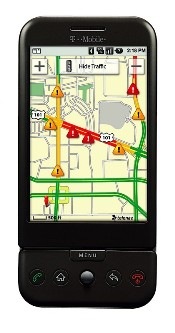Labeling the Real World
 This has been announced these days on the Rey Juan Carlos University page. It is free software for mobile phones that allows you to virtually 'tag' the real world.
This has been announced these days on the Rey Juan Carlos University page. It is free software for mobile phones that allows you to virtually 'tag' the real world.
According to this, users can link multimedia content to an object by pointing to the phone, pasting a 'virtual' tag on a real object, and the person passing by can read it. And all this from a mobile. That is what free software LibreGeoSocial (LGS) allows, a program developed by researchers at the Universidad Rey Juan Carlos for Android phones, the operating system created by Google. LGS is a georeferenced multimedia content manager. That is, it allows the user of a social network to store information (text, photos, video, audio ...) linked to a specific place. And it also has an augmented reality interface. That is to say, when the user points with the mobile to a previously labeled object, the indication that the other person has 'left' on the screen appears on the screen.
"It is a much richer experience than a traditional social network because the sensors measuring the magnetic field of new mobile phones let you know not only where the mobile is but also where it is oriented,
says Pedro de las Heras Quirós, member of the GSyC / Libresoft group and project researcher. He adds: "The augmented reality and georeferencing modules of LibreGeoSocial allow users of social networks that have gone out to interact not only with the virtual world, but also with the real world." This opens a wide range of utilities: tourist guides, citizen participation systems, social networks for people with dependency and mlearning.
 Some examples: A tourist visits a museum, points with his mobile to a picture and it appears in the screen the comments, photos etc. that another previous tourist has 'stuck' virtually on that work of art. A citizen sees an eave on the verge of falling and generates an incident that is linked to that roof. District maintenance services can automatically receive this information. When they move to the place to solve the problem they can easily locate the place thanks to the augmented reality interface. Also, until it is fixed, other users passing by can receive alerts on their mobile.
Some examples: A tourist visits a museum, points with his mobile to a picture and it appears in the screen the comments, photos etc. that another previous tourist has 'stuck' virtually on that work of art. A citizen sees an eave on the verge of falling and generates an incident that is linked to that roof. District maintenance services can automatically receive this information. When they move to the place to solve the problem they can easily locate the place thanks to the augmented reality interface. Also, until it is fixed, other users passing by can receive alerts on their mobile.
For this purpose, a municipality could use it for a survey of points of interest, such as signs, business, damaged pavement points, violations of standards, etc.
But LibreGeoSocial has another advantage: it has a semantic search engine. That is, social network nodes (multimedia content, people, events ...) are processed using a system of clustering algorithms to infer non-explicit relationships between them, allowing users to discover other users or contents on the network that are related to them in spite of belonging to different communities within the social network. Thus, for example, a user could generate a search criterion to find another user who frequents their same places or has similar hobbies.
LibreGeoSocial is composed of a server and a client application for the mobile. The server is implemented in the Python programming language. The client application is programmed in the Java language. All the LibreGeoSocial server and client source code has been published as free software, this being one of the first augmented reality applications for Android whose source code is available, and one of the few existing with Sky Map and Wikitude. The client application will also be available soon through the Android Market applications market, ready to be downloaded and run on Android phones sold in Spain by major mobile phone operators.






